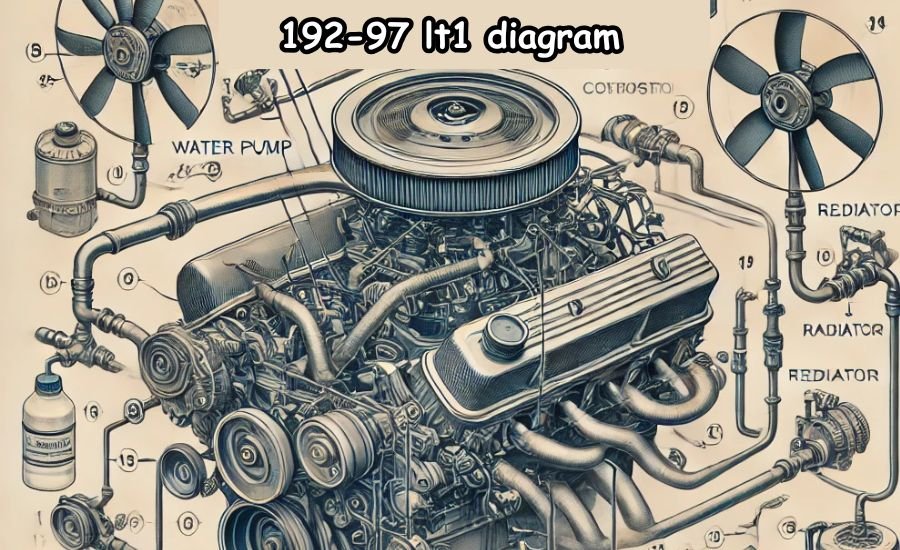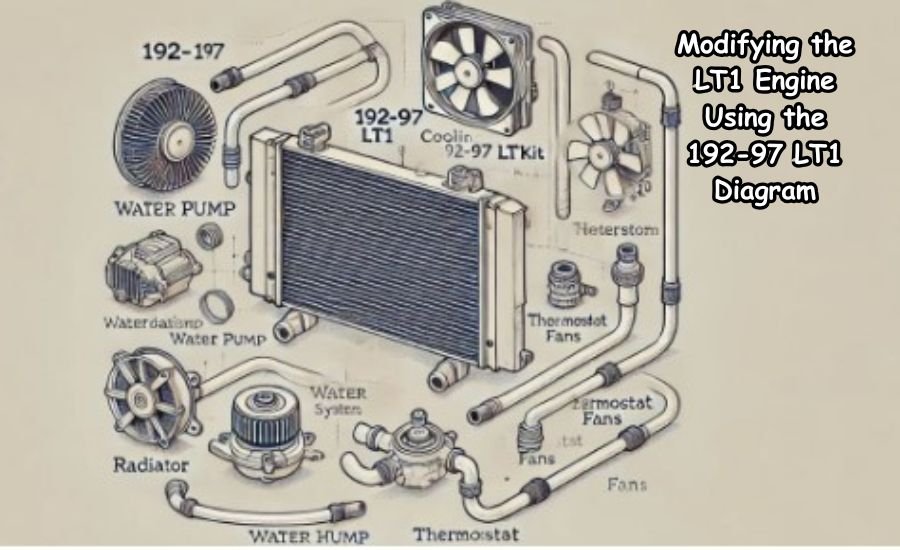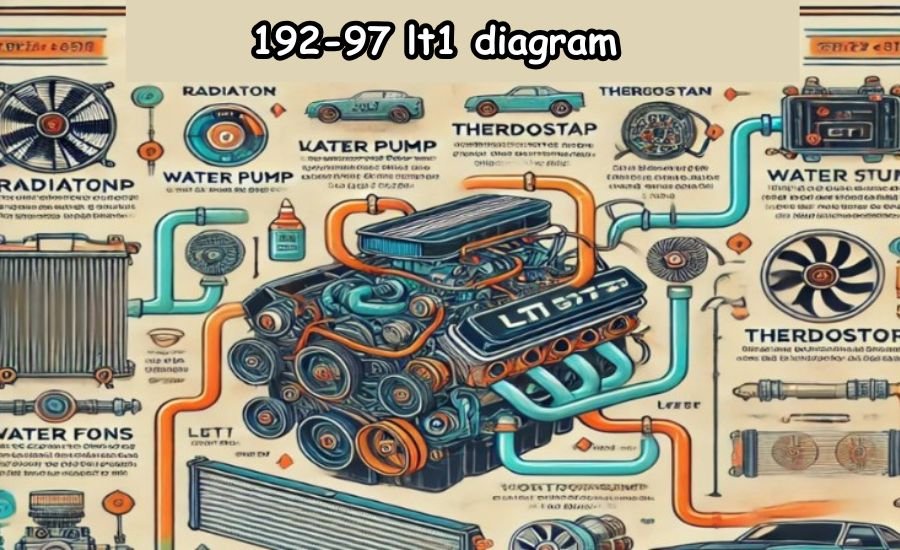The 192-97 LT1 diagram is essential for anyone wanting to understand the cooling system of an LT1 engine. This diagram shows how different parts of the engine work together to control temperature and prevent overheating. It helps identify crucial components like the radiator, water pump, and cooling lines, all of which are vital for maintaining the engine’s health. Having the 192-97 LT1 diagram on hand allows both beginners and experienced mechanics to work more efficiently.
It reduces errors and helps people better understand how each part works together in this powerful engine. In an LT1 engine, these cooling parts work as a team to keep the engine cool, especially during long drives or intense use. Without a proper cooling system, engines can overheat and cause severe damage. So, understanding the 192-97 LT1 diagram can help with proper maintenance and ensure your engine lasts longer.
Introduction to the 192-97 LT1 Diagram

The 192-97 LT1 diagram is a helpful visual tool that shows the components of the LT1 engine. It breaks down how the parts fit and work together. For car enthusiasts, or even beginners who want to learn more about car engines, this diagram is key. The LT1 engine is well-known for its high performance and has been used in many popular cars, especially in the 1990s.
Understanding the 192-97 LT1 diagram helps people easily identify different engine parts and how they function. It can be especially useful if you’re looking to perform engine repairs or maintenance. In this section, we’ll briefly introduce the LT1 engine, and then explore the importance of understanding its diagram. By the end of this guide, you’ll have a much clearer picture of how the LT1 engine operates and what role each part plays.
Understanding the Basics of the LT1 Engine
Before we dive deeper into the 192-97 LT1 diagram, it’s important to know what the LT1 engine is. The LT1 engine is a small-block V8 engine that was commonly used in Chevrolet cars like the Corvette and Camaro in the 1990s. Known for its power and reliability, the LT1 engine became a favorite for performance enthusiasts. It provides a visual breakdown of this powerful engine.
It helps car mechanics, or even those curious about how the engine works, see all the different components, like the fuel injectors, pistons, and crankshaft. This makes repairs or modifications much easier, as you know exactly where each part is located. Learning about the engine through the 192-97 LT1 diagram is beneficial, especially for DIY mechanics who want to ensure they are working on the correct parts. Understanding this engine is the first step to mastering car maintenance.
Why the 192-97 LT1 Diagram is Important
The 192-97 LT1 diagram plays a crucial role in understanding how the LT1 engine functions. Engines can be very complex, but a diagram simplifies it by showing all the main components in one easy-to-read format. For those unfamiliar with engine structures, it can be quite overwhelming to look at the engine directly.
That’s where the diagram comes in, it shows how each part connects and operates. Whether you’re working on an engine upgrade, repair, or maintenance, referring to the 192-97 LT1 diagram helps ensure you’re doing everything correctly. It’s much easier to follow the diagram rather than trying to guess where certain parts are. The diagram will guide you step-by-step, making the entire process less stressful.
Parts Highlighted in the 192-97 LT1 Diagram
The 192-97 LT1 diagram shows a detailed view of many different engine parts. Some key components include the intake manifold, fuel injectors, throttle body, and spark plugs. Each of these parts plays an important role in making the engine run smoothly. The intake manifold, for example, ensures air flows properly into the engine, while the fuel injectors supply the right amount of fuel for combustion.
By using the 192-97 LT1 diagram, you can easily locate these parts, which can make tasks like replacing a faulty injector or cleaning the throttle body much easier. For beginners, it’s a great way to get familiar with the different parts of an engine. Knowing how each part functions and where it is located helps in performing regular maintenance like oil changes or tuning. The 192-97 LT1 diagram offers an organized map of these parts, which helps both beginners and experienced mechanics keep track of what needs to be done during engine maintenance.
How to Read the 192-97 LT1 Diagram

Reading the 192-97 LT1 diagram might seem tricky at first, but with a bit of practice, it becomes easy. The diagram uses symbols and lines to represent different parts of the engine and how they are connected. By following the lines, you can see how fuel, air, and electricity flow through the engine, powering the car. One helpful tip when reading the 192-97 LT1 diagram is to break it down into sections.
Start with one part, like the ignition system, and follow how it connects to other parts like the spark plugs or the distributor. This will help you understand how the engine operates as a whole. The more you practice reading the diagram, the easier it will be to identify problems or perform maintenance. Once you get the hang of reading the 192-97 LT1 diagram, you’ll find it much easier to diagnose and fix engine issues, making it an invaluable tool for anyone working on an LT1 engine.
Common Issues Identified Using the 192-97 LT1 Diagram
Using the 192-97 LT1 diagram can help you identify common engine issues before they become major problems. One of the most frequent problems in LT1 engines is fuel injector failure. If your engine isn’t running smoothly or if you notice poor fuel efficiency, the fuel injectors might be clogged or malfunctioning. The diagram shows exactly where the injectors are located, making it easier to replace or clean them. Another common issue is overheating.
The 192-97 LT1 diagram helps you trace the cooling system, including the radiator and hoses, so you can check for leaks or blockages. By using the diagram to pinpoint the problem area, you can fix the issue quickly without causing more damage to the engine. It is a useful tool for diagnosing and solving common engine problems, saving you time and money on repairs.
Upgrading Your LT1 Engine Using the 192-97 LT1 Diagram
For car enthusiasts looking to upgrade their LT1 engine, the 192-97 LT1 diagram is an essential resource. It shows you the layout of the engine, which makes it easier to add performance parts like high-flow air filters, performance exhaust systems, or upgraded fuel injectors. Knowing where everything is located can help you plan your upgrades more efficiently.
When upgrading, the 192-97 LT1 diagram can help you avoid mistakes by showing exactly how new parts should fit in with the existing engine. This is especially important for parts like the exhaust manifold or turbocharger, which require precise installation.It serves as a roadmap for any engine upgrade project, helping you make informed decisions and avoid costly mistakes.
Using the 192-97 LT1 Diagram for Engine Maintenance
The 192-97 LT1 diagram is an excellent guide when performing routine engine maintenance. Keeping your LT1 engine in good condition requires regular checks and cleaning, and the diagram helps you locate all the essential components. Whether it’s checking the oil level, inspecting the cooling system, or replacing worn-out spark plugs, the diagram provides a clear visual of each part and its location. For beginners, the 192-97 LT1 diagram simplifies tasks like changing the oil or replacing air filters.
By following the diagram, you can ensure you’re working on the right parts and avoid unnecessary mistakes. Regular maintenance is key to keeping your LT1 engine running smoothly and efficiently, and having the diagram on hand makes the process much easier. Overall, the 192-97 LT1 diagram is an invaluable resource for anyone wanting to maintain their engine. It helps you stay organized, and it makes complex maintenance tasks simpler and quicker to complete.
Understanding the Fuel System Through the 192-97 LT1 Diagram
One of the most important parts of any engine is the fuel system, and the 192-97 LT1 diagram clearly shows how it works in the LT1 engine. The fuel system includes the fuel pump, fuel injectors, and fuel lines, all of which are essential for delivering fuel to the engine. The diagram helps you understand how fuel moves through the engine and what to check if something goes wrong.
For example, if your engine is not getting enough fuel or seems to be running poorly, the 192-97 LT1 diagram can guide you in identifying potential issues like clogged injectors or a malfunctioning fuel pump. The diagram shows where these parts are located and how they connect to the rest of the engine. Having a clear understanding of the fuel system through the 192-97 LT1 diagram can help prevent major engine problems and ensure your car is getting the fuel it needs to run efficiently.
Cooling System Breakdown in the 192-97 LT1 Diagram

The 192-97 LT1 diagram also highlights the cooling system, which is vital to keeping your engine from overheating. The cooling system includes the radiator, water pump, hoses, and thermostat, all of which work together to regulate the engine’s temperature. Understanding how these parts are connected helps ensure your engine stays cool, even under heavy use.
Using the 192-97 LT1 diagram, you can easily locate the radiator and water pump to check for any issues like leaks or blockages. If your engine is overheating, the diagram will guide you through inspecting the cooling system to identify the problem. The 192-97 LT1 diagram makes it easier for you to understand how the cooling system works and how to fix common issues, ensuring your engine stays in good condition.
Essential Information: Customer-programing-software-ham2000
Electrical System in the 192-97 LT1 Diagram
The 192-97 LT1 diagram also helps you understand the electrical system in your engine. This includes the battery, alternator, and wiring that connects all the parts of the engine. Without a functioning electrical system, the engine wouldn’t start or run properly. The diagram shows how all the electrical components are connected, helping you troubleshoot any electrical issues that may arise.
If your car’s battery isn’t holding a charge or if there’s an issue with the alternator, the 192-97 LT1 diagram helps you quickly locate these parts. This makes it easier to diagnose the problem and replace the faulty component if needed. By following the 192-97 LT1 diagram, you can get a clear picture of how the electrical system works, making it easier to identify and fix issues.
Using the 192-97 LT1 Diagram for Engine Rebuilds
For those who are rebuilding an LT1 engine, the 192-97 LT1 diagram is an essential tool. It shows where each part belongs, helping you put everything back together correctly. Rebuilding an engine can be a challenging task, but the diagram simplifies the process by providing a visual map of the engine’s components.
When disassembling the engine, you can use the 192-97 LT1 diagram to keep track of where each part goes. This is especially important for small parts like bolts and gaskets, which can easily get lost during the rebuild process. With the 192-97 LT1 diagram as your guide, you can ensure that your engine rebuild is successful and that everything is in its proper place.
Diagnosing Engine Problems with the 192-97 LT1 Diagram
The 192-97 LT1 diagram is a helpful tool for diagnosing engine problems. Whether you’re dealing with a loss of power, rough idling, or strange noises, the diagram can guide you in finding the source of the problem. By following the diagram, you can identify the part that may be causing the issue and address it quickly.
For example, if your engine is running rough, the 192-97 LT1 diagram can help you check the ignition system, fuel injectors, and air intake for any issues. This makes diagnosing problems faster and more accurate, helping you avoid costly repairs down the road. It is a powerful tool for anyone working on an LT1 engine. It simplifies the process of diagnosing and fixing engine problems, making repairs more efficient.
Modifying the LT1 Engine Using the 192-97 LT1 Diagram

If you’re looking to modify your LT1 engine for better performance, the 192-97 LT1 diagram is a great resource. Whether you’re adding a new exhaust system, upgrading the intake manifold, or installing performance parts, the diagram shows you where everything fits. This makes it easier to plan your modifications and ensure everything works together properly.
It helps you avoid mistakes during the modification process by clearly showing how each part is connected. This is especially important when working on complex modifications, like installing a turbocharger or upgrading the fuel system. By following the 192-97 LT1 diagram, you can ensure that your modifications are done correctly and that your LT1 engine performs at its best.
The Importance of the 192-97 LT1 Diagram for Beginners
For beginners who are new to working on engines, the 192-97 LT1 diagram is an invaluable learning tool. It provides a clear visual of how the engine works, making it easier to understand the different parts and their functions. Whether you’re performing basic maintenance or diving into more advanced repairs, the diagram helps you navigate the complexities of the LT1 engine.
It is also helpful for learning how to read engine diagrams in general. By studying the layout of the LT1 engine, you’ll develop a better understanding of how engines work, which will be useful when working on other types of engines in the future. It is a must-have for anyone new to car maintenance. It simplifies the process and helps beginners gain confidence in working on engines.
Conclusion
The 192-97 LT1 diagram is a valuable tool for anyone working with an LT1 engine, whether you’re a beginner or experienced. It helps make complex engine parts and systems easy to understand, showing exactly where everything is located. From the fuel system to the cooling system, the diagram helps guide you through important maintenance, repairs, and even modifications. Using this diagram ensures you can complete tasks with accuracy and avoid costly mistakes, saving both time and effort.
In conclusion, the 192-97 LT1 diagram is more than just a guide—it’s your map to understanding and mastering your LT1 engine. Whether you are performing simple maintenance, diagnosing engine problems, or upgrading parts, this diagram is your reliable resource. It not only helps with the technical side of things but also gives you the confidence to handle more challenging tasks. With the 192-97 LT1 diagram by your side, maintaining and improving your engine becomes much easier, keeping your car running smoothly for years to come.
What You Should Know: How-to-deal-with-tridyne-te-031-low-battery-warning-simple-tips-for-longer-battery-life
FAQs
What is the 192-97 LT1 diagram?
The 192-97 LT1 diagram is a visual guide that shows the different components of the LT1 engine, helping you understand the layout and function of the engine parts.
Why is the 192-97 LT1 diagram important?
This diagram is important because it helps you identify engine parts, making maintenance and repairs easier and more accurate.
Can beginners use it?
Yes, it is beginner-friendly. It simplifies complex engine details, making it easier for anyone to understand.
Does it cover all parts of the engine?
Yes, the diagram provides a detailed view of essential components like the cooling system, fuel system, and ignition system.
Where can I find the 192-97 LT1 diagram?
You can find it in LT1 engine manuals, online resources, or specific car forums and websites focused on LT1 engines.
How can it help with repairs?
The diagram shows the exact location of engine parts, which can help you perform repairs and replacements more efficiently.
Is the 192-97 LT1 diagram useful for upgrades?
Yes, it is great for understanding how to upgrade parts of your engine, as it clearly displays connections and systems.
Can I use itfor diagnostics?
Absolutely. The diagram helps in diagnosing engine problems by showing where different parts are located and how they work together.
Is the 192-97 LT1 diagram specific to certain car models?
The diagram is specifically designed for cars using the LT1 engine, commonly found in certain Chevrolet models like the Camaro and Corvette.
Do I need any special tools to use the 192-97 LT1 diagram?
No special tools are required to use the diagram. It is a guide to help you visually understand the engine layout, making tasks easier without needing extra equipment.









